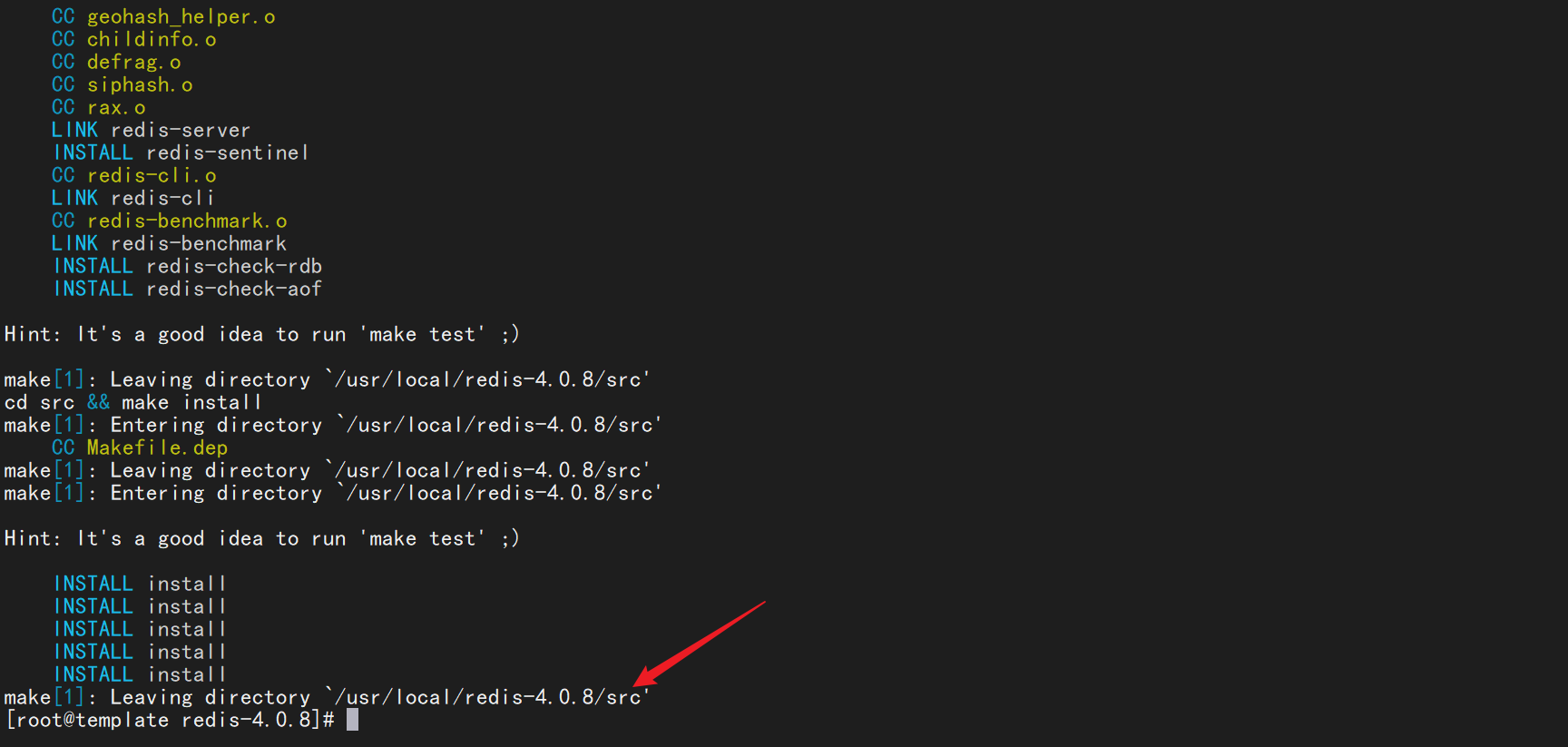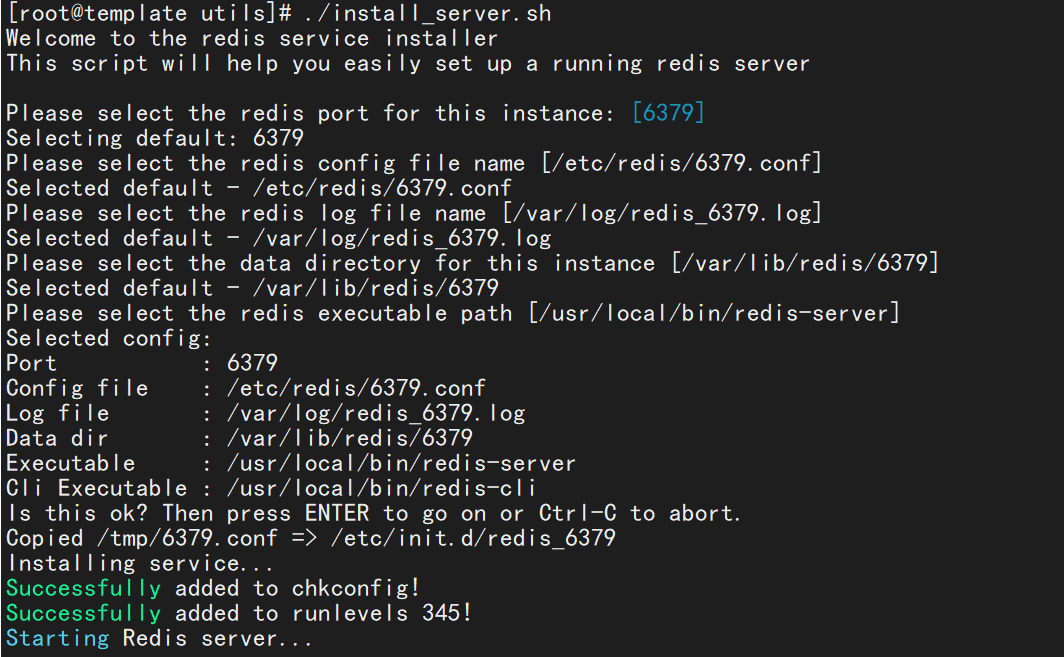非關係型資料庫---Redis安裝與基本使用
一、資料庫型別
- 關聯式資料庫管理系統(RDBMS)
- 非關聯式資料庫管理系統(NoSQL)
按照預先設定的組織機構,將資料儲存在物理媒介上(即:硬碟上)
資料之間可以做無關聯操作 (例如: 多表查詢,巢狀查詢,外來鍵等)
主流的RDBMS軟體:MySQL、MariaDB、Oracle、DB2、SQL Server;要儲存的資料是有固定格式的(例如:要向銀行存現金,需要錄入:姓名,年齡,金額,家庭住址等),並且是永久儲存的,類似這種對於同一個業務,錄入資料的方式一樣的採用關係型資料庫。
二、NoSQL(NoSQL = Not Only SQL)
意思是「不僅僅是SQL」
泛指非關係型資料庫,不需要預先定義資料儲存結構,每條記錄可以有不同的 資料型別 和 欄位個數
NoSQL主流軟體:Memcached、Redis、MongoDB、Neo4j、FlockDB
三、Redis介紹
Remote Dictionary Server(遠端欄位伺服器)是一款高效能的(Key/Values)分散式記憶體資料庫
支援資料持久化(定期把記憶體裡資料儲存到硬碟)
支援多種資料型別 string、list、hash
支援 master-slave 模式資料備份
中文網站 www.redis.cn
四、部署Redis服務
環境準備,建立template主機,ip地址為192.168.11.10
PS:官網穩定版6的版本,編譯的時候一直報錯找不到src目錄
換成4版本成功的截圖:

步驟一:直接wget下載到/root目錄下
[root@template ~]# wget -c http://download.redis.io/releases/redis-4.0.8.tar.gz
步驟二:原始碼編譯安裝
# 安裝編譯環境gcc gcc-c++
[root@template~]# yum -y install gcc
# 解壓到指定目錄,個人習慣
[root@template ~]# tar xf redis-4.0.8.tar.gz -C /usr/local/
# 進入目錄
[root@template ~]# cd /usr/local/redis-4.0.8/
[root@template redis-4.0.8]# ls
00-RELEASENOTES CONTRIBUTING deps Makefile README.md runtest runtest-moduleapi sentinel.conf tests utils
BUGS COPYING INSTALL MANIFESTO redis.conf runtest-cluster runtest-sentinel src TLS.md
# 編譯安裝
[root@template redis-4.0.8]# make && make install
# 測試
[root@template redis-4.0.8]# redis-
redis-benchmark redis-check-aof redis-check-rdb redis-cli redis-sentinel redis-server
步驟三:初始設定,設定服務執行引數
[root@template utils]# pwd
/usr/local/redis-4.0.8/utils
[root@template utils]# ./install_server.sh 執行原始碼目錄下的初始化指令碼
埠 6379
主組態檔 /etc/redis/6379.conf
紀錄檔檔案 /var/log/redis_6379.log
資料庫目錄 /var/lib/redis/6379
服務啟動程式 /usr/local/bin/redis-server
命令列連線命令 /usr/local/bin/redis-cli
# 執行初始化指令碼,一路回車即可
Welcome to the redis service installer
This script will help you easily set up a running redis server

選擇redis埠號:【6379】 回車確認
Please select the redis port for this instance: [6379]
Selecting default: 6379
選擇redis主組態檔:【/etc/redis/6379.conf】 回車確認
Please select the redis config file name [/etc/redis/6379.conf]
Selected default - /etc/redis/6379.conf
選擇redis紀錄檔檔案:【/var/log/redis_6379.log】 回車確認
Please select the redis log file name [/var/log/redis_6379.log]
Selected default - /var/log/redis_6379.log
選擇redis資料庫目錄:【/var/lib/redis/6379】 回車確認
Please select the data directory for this instance [/var/lib/redis/6379]
Selected default - /var/lib/redis/6379
選擇redis啟動程式:【/usr/local/bin/redis-server】 回車確認
Please select the redis executable path [/usr/local/bin/redis-server]
以上選擇的設定
Selected config:
Port : 6379
Config file : /etc/redis/6379.conf
Log file : /var/log/redis_6379.log
Data dir : /var/lib/redis/6379
Executable : /usr/local/bin/redis-server
Cli Executable : /usr/local/bin/redis-cli
確認,則選擇回車即可;否則按 Ctrl + C 重新設定
Is this ok? Then press ENTER to go on or Ctrl-C to abort.
Copied /tmp/6379.conf => /etc/init.d/redis_6379
Installing service...
Successfully added to chkconfig!
Successfully added to runlevels 345!
Starting Redis server...
Installation successful! #安裝成功
步驟四:檢視redis的啟動埠號
[root@template utils]# ss -lntup | grep redis
tcp LISTEN 0 128 127.0.0.1:6379 *:* users:(("redis-server",pid=9043,fd=6))
步驟五:管理redis服務,通過指令碼的方式停止redis的服務
[root@template utils]# /etc/init.d/redis_6379 stop
Stopping ...
Redis stopped
[root@template utils]#
[root@template utils]#
[root@template utils]# ss -lntup | grep redis
步驟六:重新開啟redis服務
[root@template utils]# /etc/init.d/redis_6379 start
Starting Redis server...
[root@template utils]# ss -lntup | grep redis
tcp LISTEN 0 128 127.0.0.1:6379 *:* users:(("redis-server",pid=10977,fd=6))
步驟七:連線服務:redis-cli 預設連線本機的redis服務
[root@template utils]# redis-cli
# 使用ping命令,檢視連線是否成功,結果是PONG,則代表redis正常連線
127.0.0.1:6379> ping
PONG
127.0.0.1:6379>
127.0.0.1:6379> keys * #使用keys命令,檢視當前庫下的所有資料
127.0.0.1:6379> set school tarena #使用set命令,存入資料,school:tarena
127.0.0.1:6379> get school #使用get命令,從記憶體中,取出變數"school"對應的值
127.0.0.1:6379> keys * #使用keys命令,檢視當前庫下的所有資料
127.0.0.1:6379> exit #斷開redis連線
五、基本操作命令
PS:可以藉助官方檔案:https://docs.redis.com/
[root@template utils]# redis-cli
127.0.0.1:6379> ping
PONG
127.0.0.1:6379>
# set命令,存資料,給變數賦值(x:99)【給單個變數賦值】
127.0.0.1:6379> set x 99
# mset命令,存資料,給變數賦值(i:77),(j:88),(k:99)【給多個變數同時賦值】
127.0.0.1:6379> mset i 77 j 88 k 99
# get命令,取資料,獲取變數i的值【獲取單個變數的值】
127.0.0.1:6379> get i
# mget命令,取資料,獲取多個變數j,k,x的值【獲取多個變數的值】
127.0.0.1:6379> mget i j k
1) "77"
2) "88"
3) "99"
# keys命令,顯示所有的變數名【* 代表所有】
127.0.0.1:6379> keys *
1) "j"
2) "i"
3) "k"
4) "x"
# keys命令,顯示變數名為一個字元的變數【? 代表單個字元】
127.0.0.1:6379> keys ?
1) "j"
2) "i"
3) "k"
4) "x"
# keys命令,顯示變數名為六個字元的變數【? 代表單個字元】
127.0.0.1:6379> keys ??????
# keys命令,顯示age的變數名,不存在,即為空
127.0.0.1:6379> keys age
(empty list or set)
# keys命令,顯示school的變數名,存在
127.0.0.1:6379> keys school
# type命令,檢視變數i的型別【string 為字元型別】
127.0.0.1:6379> type i
string
# set命令,存資料,給z賦值(z:10)【給單個變數賦值】
127.0.0.1:6379> set z 10
# type命令,檢視變數z的型別【string 為字元型別】
127.0.0.1:6379> type z
string
# lpush命令,存資料,給變數賦值(hostname:pc99,pc88)【列表型別】
127.0.0.1:6379> lpush hostname pc99 pc88
(integer) 2
# type命令,檢視變數hostname的型別【list 為列表型別】
127.0.0.1:6379> type hostname
list
# exists命令,檢查變數是否存在,重複給一個變數賦值,會覆蓋上一次變數的值
返回值為1,代表變數存在;返回值為0,則代表變數不存在
127.0.0.1:6379> exists hostname
(integer) 1
注意:在redis中,使用set和mset存入的資料,資料型別都是字元型別
# keys命令,檢視redis中所有的變數
127.0.0.1:6379> keys *
# ttl命令,檢視變數有效期,-1 為永不過期【不重啟redis服務和清空記憶體的情況下】
127.0.0.1:6379> ttl j
(integer) -1
# expire命令,設定變數j的有效期為20秒
127.0.0.1:6379> expire j 20
(integer) 1
# ttl命令,檢視變數有效期,16秒
127.0.0.1:6379> ttl j
(integer) 16
# ttl命令,檢視變數有效期,當變數的有效期為-2時,到期,該變數會被刪除
127.0.0.1:6379> ttl j
(integer) -2
# exists命令,檢查變數是否存在,變數被刪除,返回值為1,代表變數存在;返回值為0,則代表變數不存在
127.0.0.1:6379> exists j
(integer) 0
# select命令,切換庫,切換到編號3的庫下
127.0.0.1:6379> select 3
# 當前處於編號3庫下, select命令,切換到編號1的庫下
127.0.0.1:6379[3]> select 1
OK
# 當前處於編號1庫下, select命令,切換到編號0的庫下
127.0.0.1:6379[1]> select 0
OK
# 當前處於編號0庫下,檢視0庫下所有的變數
127.0.0.1:6379> keys *
# 將編號0庫下的變數school,移動到編號1的庫下
127.0.0.1:6379> move school 1
(integer) 1
# 將編號0庫下的變數x,移動到編號2的庫下
127.0.0.1:6379> move x 2
(integer) 1
# 編號0庫下,變數school和變數x消失
127.0.0.1:6379> keys *
# 檢視編號1庫下的所有變數,變數"school"移動過來了
127.0.0.1:6379> select 1
127.0.0.1:6379[1]> keys *
# 檢視編號2庫下的所有變數,變數"x"移動過來了
127.0.0.1:6379[1]> select 2
127.0.0.1:6379[2]> keys *
# save命令,把記憶體中的資料儲存到硬碟中
127.0.0.1:6379[2]> save
127.0.0.1:6379[2]> exit
# 執行save命令後,記憶體中的資料被儲存到下面檔案中
[root@template utils]# ls /var/lib/redis/6379/
dump.rdb
# 連線資料庫 redis-cli
# del命令,刪除變數i
127.0.0.1:6379> del i
(integer) 1
# flushdb命令,刪除當前所在庫下的所有資料
127.0.0.1:6379> flushdb
# 檢視編號0庫下的所有變數,為空
127.0.0.1:6379> keys *
127.0.0.1:6379> select 1 #切換到其他庫下,還有資料
127.0.0.1:6379[1]> keys *
# flushall命令,刪除redis所有庫下的資料
127.0.0.1:6379[0]> flushall
127.0.0.1:6379[1]> keys *
127.0.0.1:6379[1]> select 2
127.0.0.1:6379[2]> keys *
# shutdown停止服務
127.0.0.1:6379[2]> shutdown
not connected> exit
[root@template utils]]# ss -antlp | gre p6379
六、組態檔解析
1、檢視redis組態檔資訊,修改設定時,在對應的模組下寫即可
[root@template ~]# vim /etc/redis/6379.conf
.........
############################# INCLUDES ##############################
.........
############################# MODULES ##############################
.........
############################# NETWORK ##############################
.........
############################# GENERAL ##############################
2、資料單位,不區分字母大小寫
[root@template ~]# vim /etc/redis/6379.conf
# 1k => 1000 bytes
# 1kb => 1024 bytes
# 1m => 1000000 bytes
# 1mb => 1024*1024 bytes
# 1g => 1000000000 bytes
# 1gb => 1024*1024*1024 bytes
3、檢視redis常用設定資訊
守護行程:指程序會一直存在,等待使用者存取(耗資源,使用者端存取速度快)
非守護行程:當服務執行後,如果一段時間內沒有使用者存取,服務會進入到休眠狀態;當有使用者存取時,服務會被喚醒,供使用者去存取(節省資源,使用者端存取速度慢一些)
70 bind 127.0.0.1 #指定客戶存取的IP地址,這裡只允許本機存取
93 port 6379 #指定redis的存取埠
137 daemonize yes #以守護行程方式執行(程序一直存在,等待使用者存取)
172 logfile /var/log/redis_6379.log #記錄redis執行的啟動和執行過程中的資訊
187 databases 16 #資料庫個數,預設16個,可以修改
264 dir /var/lib/redis/6379 #定義資料庫目錄
533 # maxclients 10000 #使用者端同時存取redis的並行數量,預設10000
4、記憶體管理,檢視記憶體清除策略
.........
562 # MAXMEMORY POLICY: how Redis will select what to remove when maxmemory
563 # is reached. You can select among five behaviors:
564 #
565 # volatile-lru -> 向redis中存入資料時,資料已滿,則會在設定了TTL過期時間的變數中選擇,刪除最近最少使用的key,用於存放新的key;
566 # allkeys-lru -> 向redis中存入資料時,資料已滿,則會在所有的變數中選擇,刪除最近最少使用的key,用於存放新的key;
567 # volatile-lfu -> 向redis中存入資料時,資料已滿,則會在設定了TTL過期時間的變數中選擇,刪除使用頻率最少的key,用於存放新的key;
568 # allkeys-lfu -> 向redis中存入資料時,資料已滿,則會在所有的變數中選擇,刪除使用頻率最少的key,用於存放新的key;
569 # volatile-random -> 向redis中存入資料時,資料已滿,則會在設定了TTL過期時間的變數中選擇,隨機刪除key,用於存放新的key;
570 # allkeys-random -> 向redis中存入資料時,資料已滿,則會在所有的變數中選擇,隨機刪除key,用於存放新的key;
571 # volatile-ttl -> 向redis中存入資料時,資料已滿,刪除最近過期的key;
572 # noeviction -> 向redis中存入資料時,資料已滿,顯示報錯提示;
5、記憶體優化設定,
從實體記憶體中劃分多少記憶體給redis使用,這裡沒有指定,則代表將本機的所有實體記憶體交給redis去使用
560 # maxmemory <bytes>
#maxmemory-policy 定義當記憶體空間不足時,刪除已儲存資料的方式,策略為 noeviction,即,即使記憶體使用完了,也不刪除已儲存的資料
591 # maxmemory-policy noeviction
#當使用lru,lfu,ttl 策略時,需要指定key模板的個數
602 # maxmemory-samples 5
6、修改redis執行引數,修改密碼,IP地址和埠號
[root@template ~]# /etc/init.d/redis_6379 stop #停掉redis的服務
[root@template ~]# vim /etc/redis/6379.conf
70 bind 192.168.4.50 #如果想讓其他主機存取本機,修改監聽地址為本機網路卡地址
93 port 6350 #修改埠號為6350
501 requirepass 123456 #取消註釋,修改使用者連線redis的密碼為123456
啟動redis的服務
[root@template ~]# /etc/init.d/redis_6379 start
檢視redis服務的埠號
[root@template ~]# ss -ntulp | grep redis
七、連線redis服務
方法一:登入redis以後,輸入連線密碼
-h 指定要連線的主機,-p(小寫) 指定連線埠號
[root@template ~]# redis-cli -h 192.168.4.50 -p 6350
192.168.4.50:6350> auth 123456 #auth 後跟上連線密碼,否則無法正常使用
192.168.4.50:6350> ping
192.168.4.50:6350> exit
方法二:連線redis時,輸入連線密碼
-a 指定連線密碼
[root@template ~]# redis-cli -h 192.168.4.50 -p 6350 -a 123456
192.168.4.50:6350> ping
192.168.4.50:6350> exit
八、停止redis服務
當修改了redis服務的IP地址,密碼和埠號以後,則無法通過指令碼來停止redis服務
指令碼停止服務針對的是redis服務預設的IP地址,密碼和埠號
連線上redis, 使用shutdown來停止服務
[root@template ~]# redis-cli -h 192.168.4.50 -p 6350 -a 123456 shutdown
[root@template ~]# ss -ntulp | grep redis
[root@template ~]# /etc/init.d/redis_6379 start #啟動服務
-------------------------------------------
個性簽名:今天做了別人不想做的事,明天你就做得到別人做不到的事,嘗試你都不敢,你拿什麼贏!
如果覺得這篇文章對你有小小的幫助的話,記得在右下角點個「推薦」哦,博主在此感謝!